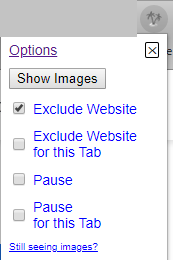As a software engineer, I used to spend a lot of time building, designing, and tweaking websites. One of the things you learn very quickly is that images are powerful. As Scott Galloway, NYU Stern Professor, points out in his latest book The Four,our brains process imagery 60,000 times faster than text, a relatively recent invention in evolutionary time. Put a picture in a sea of text and we can’t help but look at it first. Social media companies picked up on this and put a premium on sharing images. When Facebook created their form for posting content, they included two icons related to images and the phrase “Photo/Video” twice. They even include a photo of yourself to remind you how good your photos look.

This doesn’t only happen on social media though. If you’ve ever tried to read an article online and been distracted by the clickbait on the gutters of the site, you know what I’m talking about. Many content companies engage in A-B testing to figure out which images are the most likely to be clicked.
One day I got fed up and decided to remove the images from my browsing experience. Within 5 minutes, the web was transformed. My behavior online changed almost instantaneously. Here are a few of the effects:
- Less time shopping. If you shop online you know how easy it is to get caught up in optimizing. Variables like price, condition, elegance, and shipping times pile up and create analysis paralysis. You start to wonder whether a different pair of shoes would more accurately express your sense of style. Forty-five minutes later, you are having an existential crisis about whether you love or hate zippers on shoes. Without all those alluring product images, I buy less.
- Wild amounts of productivity. Almost none of my work-related browsing involved looking at images. Normally it is hard to stay focused because the rest of the internet is so much more compelling than work tasks. Since opening a new tab and spiraling down an internet rabbit hole was so easy, I spent a lot of time at work not working. Once I removed the images, most of the temptations become much less tempting. Paradoxically, this also meant I was more aware of when I needed a break. Instead of feeling worn out but unable to take a break until I actually did some work, I was able to feel my brain turn to mush and step away from my desk to refresh.
- Less inflammatory news. I’ve always tried to balance staying informed with keeping from being highjacked by negative and fear-based news. That challenge is all but erased by removing images. Without images, I’m able to read articles to their conclusion and get the facts, while avoiding much of the spin and controversy.
- Forced reflection. When I automatically opened up LinkedIn for the fifth time while waiting for another page to load, it became crystal clear where my digital bad habits lay. I had become so impatient I couldn’t wait a moment for a page to load. Since I wasn’t getting the payoff of seeing images from the LinkedIn feed, I felt like I was sprinting into dead end alleys. After doing that several times, I had to face the ugly truth that I’d wrapped up parts of my self in an unspoken competition to be the most interesting and relevant person on the digital block.
- Better IRL connections. When a friend posts pictures of their latest vacation on social media, the version you receive in your news feed is not all the news fit to print, it is all the news fit for consumption by literally anyone in your friend’s network. Later when you see your friend, you’ve seen the pictures, captions, and comments, what more do you need to know? After a cursory question or two, you both dive back into your smartphones. When you don’t see their pictures online, you start to ask them about their trip in person and something incredible happens: you have a conversation only you two could or would have. You notice things in the pictures they show you and ask questions only you would ask. Instead of a Vaseline smudged highlight reel, you start to uncover the real experiences: the awkward moments that are best enjoyed weeks later, the taxi ride after dark in a country where you don’t speak the language, the spiritual epiphany you had during a haircut. Our lives are infinitely complex and full of contradictions, by sharing those with friends and family we understand them and ourselves in new ways and give them permission to open up as well.

Maybe you don’t need to remove images from the internet to clean up your digital disposition. On some level, we are often aware of more of our habits than we consciously acknowledge. This experiment isn’t just about self-knowledge, however. It is about changing the default setting online so that I can be more intentional and disciplined around where I choose to invest my time. More time spent on newsfeeds means less time cooking meals, talking to friends, figuring out why you feel in a funk. Taking the images off the web is like removing nicotine from cigarettes.
The disturbing truth that drove me to such extreme measures is that I was not capable of spending a little bit of time online if all of the sites had images. Instead of lamenting my lack of self-control, I broke the rules. I still haven’t added images back. I have left a dead-end job, started a business, opened up additional time for friends, family, and newborn daughter.
Technical note:
If you’d like to try out the internet without images, install Wizmage Image Hider into your browser (a free and open-source Chrome Extension).
If there is a page you need to allow an exception for just open check “Exclude Website” through the extension’s icon:

Unfortunately, this will not work on a smartphone.


